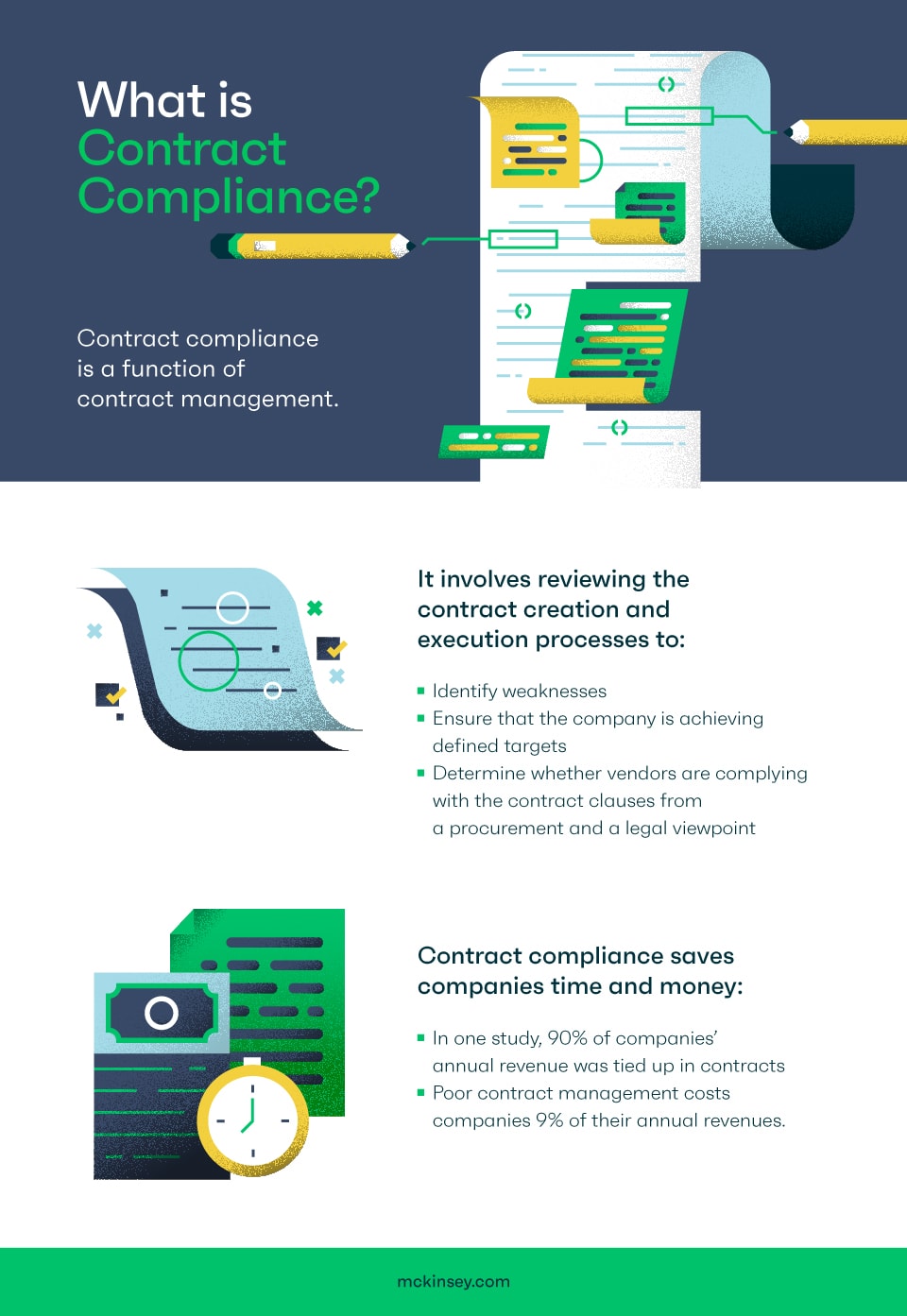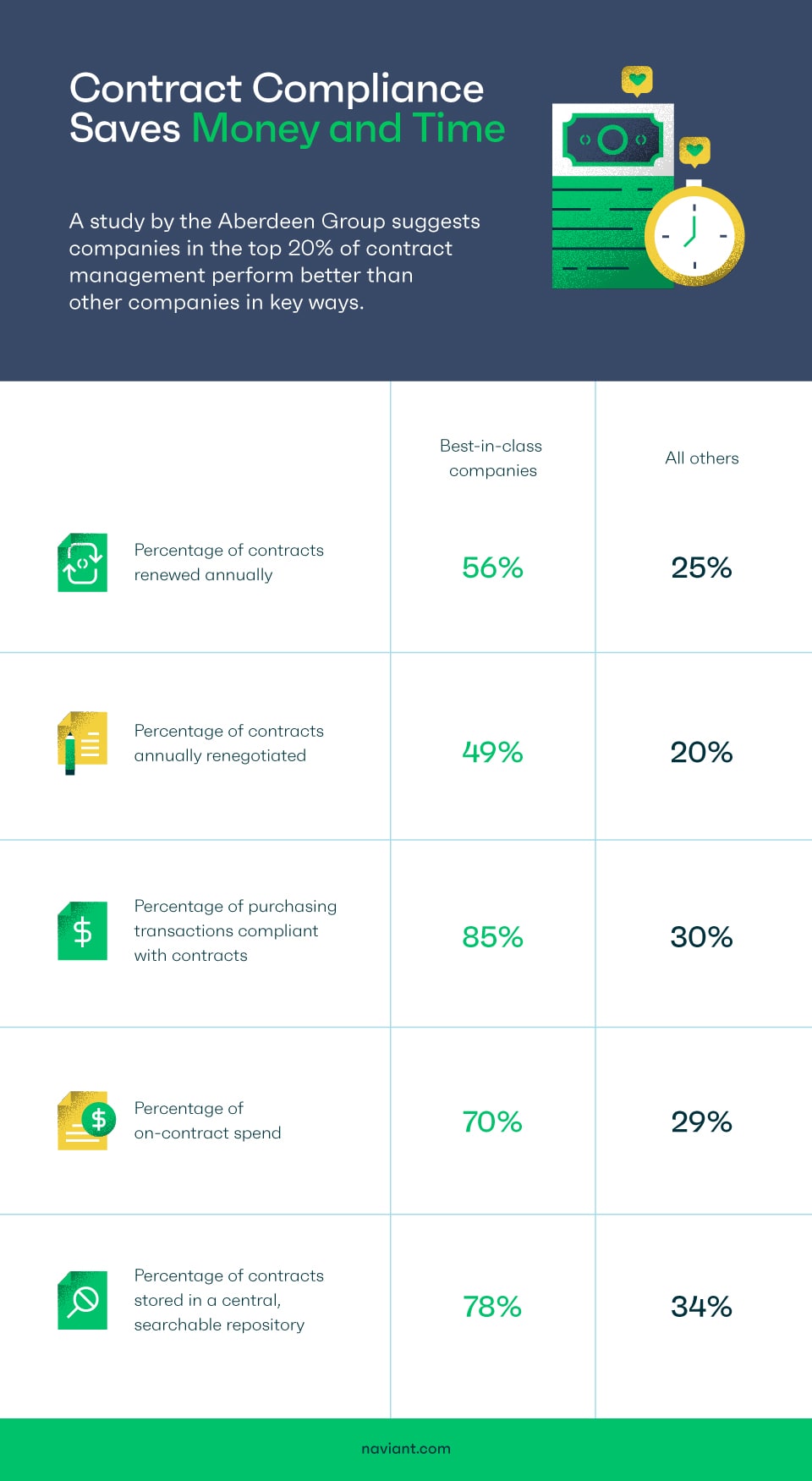Many companies across industries devote a large portion of their spending to contracts. The global management consulting firm McKinsey & Company found that in the utilities, aerospace, defense, and food manufacturing industries, companies lock up at least 90 percent of their annual revenues in contracts. Yet most companies devote a tiny fraction of spending to procurement operating expenses including contract development and vendor management. By failing to invest in proper contract management, companies lose up to 9 percent of their annual revenues. A successful contract compliance program can help remedy these leakages.

This article will focus on how to improve contract compliance by creating templates, establishing approval workflows, prioritizing the vendor relationship, monitoring performance, auditing contracts, and establishing employee compliance programs.
Best Practices for Contract Compliance
Follow these steps to improve your company’s contract compliance.
Create standardized templates for employees to use
A standardized contract management process minimizes noncompliance. This process can include numerous factors, one of which should include creating templates and boilerplate language for use by employees. Maintaining updated templates saves legal departments time because they can spend less time creating contracts. Having templates and defining parameters for when a team can make changes to the templates provides employees with greater autonomy to negotiate.
As a rule, templates favor the drafter. Yet as a drafter, it’s best to make sure templates are reasonable for both parties. The first draft sets the emotional tone for negotiation, and a vastly asymmetrical template may induce antagonism. Also, one-sided contracts increase negotiation time. Since time is money, consider the costly delays that a vastly unfair contract will cause.
Guide employees on when to use the templates and when to seek approvals for template changes. For example, for a master services agreement template for a sales team, provide specific parameters for permitted changes. For instance, state that salespeople can use the sales template without approval as long as the counterparty doesn’t make changes to the liability, insurance, or indemnity clauses.
To create a template library, gather a small set of sample contracts, including terms from competitors. Identify key terms to include, then create a logical contract structure. Draft terms from scratch using the samples as models. Eliminate unnecessary wording and simplify as much as possible. Add more templates to the library, maintaining consistency in the terms and structure of the templates.
Remember that contracts are living documents. Don’t create templates and leave them to stagnate. Instead, review standardized terms and contracts annually at a minimum, as regulations and industry standards fluctuate.
Establish an approval workflow
When a company drafts or receives a contract, who within the organization must approve it before execution? Many companies approve contracts through a series of emails, phone calls, texts, or conference calls. But using varied methods can lead to confusion, especially if a company must do an audit trail to determine how it approved specific terms.
An approval workflow automates the control of approvals and method of requests, which creates a more efficient process for reviewing and finalizing contracts. It also saves time by giving employees clearly defined steps for obtaining approvals to new contracts or versions of contracts.
To establish an approval workflow, assign a chain of individual approvers based on a set of rules. Determine your approval workflows based on the type of contract, the department or business unit involved, the counterparty, or another factor that works best for your organization. Then set deadlines for the approval process. For instance, consider stating that the turnaround time for approvals should be two business days.
Also, maintain a log of approval workflows, and note the location of every existing contract and its place in the approval workflow. Log the individuals who can approve specific contracts, and keep a record of all contracts and their progress in the approval process.

Embrace flexibility and transparency in the contractual relationship
Flexibility is critical for maintaining long-term relationships, both personally and professionally. The same principle rings true for contractual relationships. Regardless of the contractual requirements, acting rigidly in the performance of a contract can sour relationships with vendors, damage an organization’s reputation, and potentially lead to loss of future business. Providing reasonable flexibility throughout the execution of the contract strengthens and lengthens the term of partnerships with vendors.
Along with flexibility, it’s important to be transparent and communicate effectively to prevent minor issues from devolving into serious obstacles. Whatever the issue and whoever’s at fault, disclose problems to necessary parties immediately. Addressing issues promptly builds trust.
Monitor contract performance
Most companies lack the resources to monitor contract performance continuously, but it’s important to determine reasonable check-in times to monitor performance. Doing so can help ensure that all involved parties adhere to a contract. In a study, McKinsey & Company reviewed more than 100 contracts against 60 criteria and discovered that more than 75 percent of them lacked thorough key performance indicators (KPIs) to help companies monitor vendors’ performance. Companies “often fail to review and enforce terms on a regular basis,” according to the study authors.
Set and regularly review a vendor’s KPIs to help ensure consistent quality in the product or services, adhesion to the agreed timeline, and cost effectiveness. Cost effectiveness includes not only the price terms of the contract, but anything within the performance that requires additional unanticipated time or resources.
Companies can’t manage service and goods providers once and then check it off a list. Nor can they randomly pay attention to vendors’ performance. Instead, businesses should commit to regularly reviewing vendors’ performance against plainly defined KPIs. To streamline the process, require vendors to submit monthly or quarterly reports on their progress, and assign a single person within your organization to review each contract.
Conduct a contract compliance audit
When a company performs a contract audit, it evaluates contracts proactively to verify the consistency of vendors’ internal policies and systems. Companies should regularly do contract audits to inspect vendors’ business and financial records. Consistent auditing identifies and mitigates emerging issues before they transform into major problems for involved parties. If a vendor deviates from its contract regularly, it may impact the profitability of the company and the efficiency of the operations. Audits shine a light on what’s working and what isn’t within a contractual relationship.
Further, contract compliance audits, when conducted effectively, can improve your company’s processes. For instance, they may help companies devise ideas for better contract terms, provide insight into whether personnel adhere to internal policies, and offer a chance to document a vendor’s non-compliance.
When conducting an audit, clearly define and communicate its objectives and scope. The objective may be to deter fraud, correct vendor overbilling, reduce redundancies and cost leakages, improve a company’s processes, or manage risk.
Put careful thought into timing the initiation of an audit. Ideally, perform audits at a point in a contract where the company possesses greater leverage than the other party and when the vendor has cash available to correct any overpayments. Avoid scheduling contract audits at the same time as devoting significant resources to other intense tasks, such as during tax season.
When communicating a desire to conduct an audit, it’s best to remain sensitive to the vendor and avoid presenting the intention in a hostile manner. Instead, frame the audit as a necessary collaboration between two partners that can help both parties be more successful.
Beginner auditors should start with small sets of similar contracts. For example, begin by auditing freight forwarder contracts to gain experience and learn lessons to employ on your next set of audits.
Finally, create a report to document your best practices. This helpful guide will assist the organization during future audits.
Implement and track internal compliance programs
It’s not sufficient to create workflows and a template repository. It also isn’t enough to have a competent legal department or general counsel. An organization can only optimize compliance if every employee prioritizes it, too. Companies must regularly train employees on compliance issues relevant to their roles and industry.
Further, all employees must feel that they have an important stake in the overall organization’s success through ensuring compliance, and managers play an important role. In an Ernst and Young survey of 3,000 executives, 42 percent of executives would justify behaving unethically to meet financial goals. Unfortunately, without strong leadership from management, employees won’t be sufficiently motivated to meet compliance goals. To increase compliance with all employees, start by gaining the buy-in from team leaders, who can then emphasize compliance as an organization-wide priority.
Also, devote resources to the company’s compliance training program. Employee compliance training programs tend to be inadequate. Many employees view training programs as boring requirements to speed through and check off.
But experts Hui Chen and Eugene Soltes, writing for Harvard Business Review, argue that implementing more effective measurement tools may reverse the general failure of employee training programs to increase compliance. Some companies use invalid metrics to measure the quality of their training programs. For example, a company may consider the completion rate of a training program as evidence of its success rather than tying the program to a clearly defined and preferred outcome. Instead, companies should track metrics that indicate a compliance training program is successful, such as changes in employee behavior or increases in employees’ understanding of the topic.

Conclusion
Given that companies devote so much time and money to obtaining and performing contracts, it makes sense that inefficiencies in the management process can lead to notable losses over time. By implementing a contract compliance program, beginning with the steps above, companies will save time, money, and resources.
